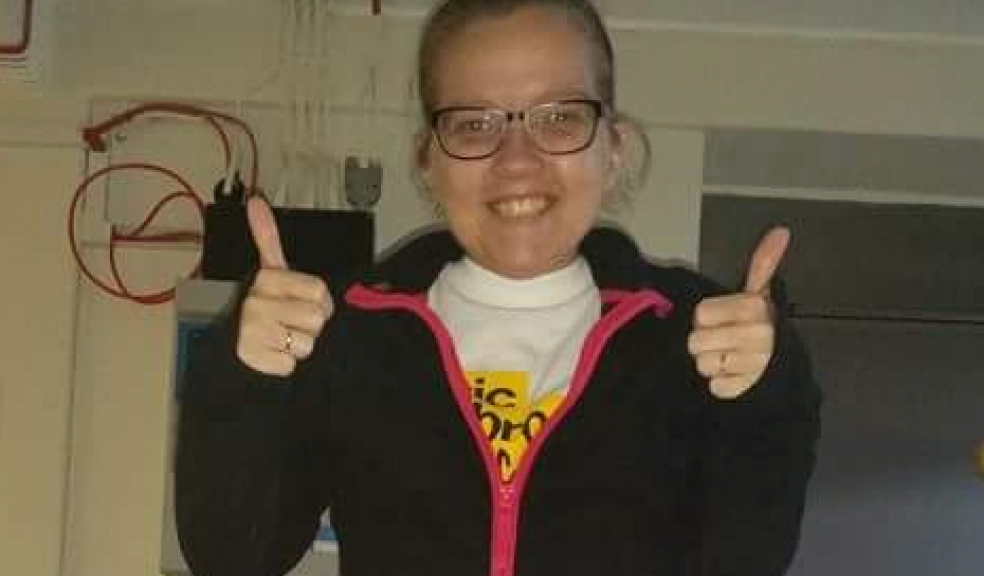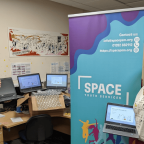
Petite Plymouth woman in pioneering operation
A petite Plymouth woman with cystic fibrosis has received a life-saving double lung transplant after highly-skilled surgeons used a pioneering technique to safely ‘downsize’ a pair of donor lungs.
Hayley Wall, 27, desperately needed a transplant after her health deteriorated due to the illness.
The inherited condition, which damages the lungs and digestive system, can also lead to poor growth. At just 4ft 8in and six-and-a-half stone, Hayley knew her size would make it difficult to find donor lungs small enough to be suitable for a transplant.
With time running out to find a match, the team at Harefield Hospital in north-west London, a specialist heart and lung hospital and one of the world’s most experienced cardiopulmonary transplant centres, concluded that Hayley’s best chance of survival was a lobar lung transplant. This meant taking part of some larger donor lungs to fill the space Hayley’s damaged lungs occupied, rather than implanting the whole donor lungs.
Lungs are made of separate units, known as lobes, which each contain blood vessels, airways and lung tissue. The right lung contains three lobes and the left lung has two. When her donor lungs became available, surgeons at Harefield Hospital used revolutionary transplant technology, known as the Organ Care System, to ventilate them outside of the body and separate the individual lobes to ensure a perfect fit for Hayley.
After waiting for 18 months, Hayley had her successful transplant in December and is now recovering well at home.
Hayley was diagnosed with cystic fibrosis from birth. Around the age of 14 she started to have recurrent chest infections and her condition progressively worsened. For the two years before her transplant Hayley needed to use portable oxygen constantly and was frequently admitted to hospital.
Hayley’s long-term use of some types of antibiotics also resulted in severe hearing loss, for which hearing aids did not help. She now communicates by lip reading.
Her older sister Gemma also had cystic fibrosis and sadly died in 2010, aged 26. Hayley, who used to volunteer at a nursery, said: “Life has been tough in the last couple of years. I had always said I didn’t want a transplant but after Gemma died I asked my consultant to write to the transplant team at Harefield Hospital to assess whether or not I was suitable for one.
“I was told I could be waiting for more than 18 months and that my small size would make it difficult to find a matching pair. It was mentioned that one option could be to cut donor lungs down to size to make them fit.
“I was put onto the waiting list in early 2014 but I was scared because my lung function was dropping and I was approaching the same age as Gemma when she died.”
Last December, shortly after a month-long stay in her local hospital, she got the call to say suitable lungs had been found.
“I was excited but I felt numb. I went to Harefield Hospital with my dad and when it was time to go, I cried and hugged my mum goodbye. I told her I’d see her soon, and she said: ‘You’d better.’
“I’d had a false alarm before, but this time I thought it might be my chance.
“After we arrived at Harefield the surgeon explained that the donor lungs were big and could be cut down to the right size for me, so I wouldn’t have the whole lungs transplanted.
“I knew the surgery was complex but all I wanted to do was have the transplant if it meant I would wake up and finally be able to breathe.”
She woke up the next day in intensive care. “I was told to take a deep breath which was scary because I never could before. As more days went by I could take deeper breaths. After 27 years of suffering, it was a wonderful feeling.
“At first I found the concept of donor lungs being cut to fit me quite scary, but I’m amazed by the technology and surgeons’ techniques that allowed it to happen – they saved my life and I can breathe with my new lungs better than ever, even though I don’t have complete lungs.
“Getting my new lungs before Christmas was the best gift I could receive. I’m very grateful to my donor and their family and I will do my donor proud. It took one person singing the Organ Donor Register to save my life.
“Now there is even a chance that I’ll be able to get my hearing back because I may be able to have a cochlear implant, which I was too ill to have before.”
Hayley’s father Wayne Quick, 54, said he was over the moon when the call came to say lungs had been found for Hayley.
He said: “The surgeons had previously explained how the donor lungs would be kept in a special box to keep them working while they were trimmed to fit Hayley. It all sounded so futuristic and I never thought it would be possible to perform a transplant in that way.
“We are lucky we could come to Harefield, where the surgeons have the equipment and skills to do this surgery.
“Hayley was discharged on New Year’s Eve and is doing so well. We still have hurdles in front of us but her quality of life has been transformed.
“Hayley may have the looks of a lamb but she has the heart of a lion – I’m so proud of her.”
Her transplant surgeon, Mr Fabio De Robertis, said: “Very petite patients tend to remain on the waiting list for a long period and can sometimes run out of time waiting for organs of the right size to become available.
“Small patients have small lungs, so it is not always possible to transplant an average-sized lung. Usually we use a technique known as lung volume reduction where we essentially ‘shave off’ some areas of the donor’s lungs; but for some patients, including Hayley, the organs are still too big afterwards.
“To carry out a lobar transplant, where we remove lobes from each donor lung to match the size of the recipient’s lungs, the donor needs to be significantly taller than the recipient so that the lobe used is as big as the patient’s entire lung.”
Mr De Robertis was able to carry out Hayley’s transplant with great precision thanks to the Organ Care System. Developed by TransMedics in the US, the portable device keeps the lungs ‘breathing’ outside the body from the moment they are removed from the donor until they are ready to be implanted in the recipient. Conventionally, organs are placed on ice to preserve them while they are transported from the donor to the recipient.
However, with the Organ Care System the lungs are placed in a sealed plastic box with a pump inside that provides a constant supply of blood to the organ. A ventilator inflates and deflates the lungs, effectively mimicking the same conditions the lungs would have in the body.
Mr Dr Robertis explained: “When the lungs are placed in the module they keep their shape and size, which gives surgeons a good idea of their volume. The donor lungs also sit in the position they would do in the body so it easier to separate the lobes.
“Removing lobes from lungs while they are preserved on ice is technically more challenging because the organs can move around and they are not placed in their natural position.
“We have developed a lot of experience using the Organ Care System at Harefield, which means we are confident using it for more complex transplant procedures. We have surgeons who perform routine lobectomies at the hospital, for patients with lung cancer for example, so we can combine our specialist skills to carry out lobar lung transplants safely.
“In this particular case I opened Hayley’s chest and measured the space occupied by her own lungs. I then measured the donor lungs as they were positioned in the Organ Care System. With the help of consultant thoracic surgeon, Mr Niall McGonigle, we removed two lobes from the right donor lung. Hayley’s chest was so small on this side that a single lobe from her donor filled the space. On the left side we used lung volume reduction techniques to make it the right fit for Hayley.
“The lobes work independently of each other but perform the same function, so the important thing is to have the correct amount of lung tissue inside the chest.
“This type of transplant is more complex than a typical lung transplant but it can save the lives of patients who otherwise could die on the waiting list.”
Mr De Robertis praised the team at TransMedics, who quickly located the nearest disposable module in Europe after Hayley’s donor lungs were found and arranged to ship it to the donor hospital just in time.
He added: “We are lucky that we can access this technology at Harefield – without it we may not have been able to go through with her lifesaving transplant. We are especially thankful to TransMedics who went the extra mile to make her operation possible.”











